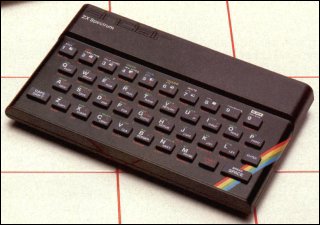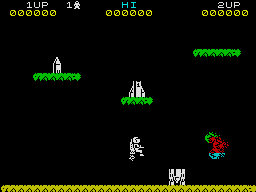|

The legendary rubber-keyed
ZX Spectrum was for many millions of Britons their
first introduction to computing. Originally released
in April 1982, it had been designed (under the
working name of "ZX82") with the same
philosophy in mind as with the ZX81
- namely, to be the cheapest colour home computer
on the market. The hardware was designed by Richard
Altwasser of Sinclair Research, while the software
was written by Steve Vickers (who subsequently
wrote the Spectrum manual), on contract from Nine
Tiles Ltd, the authors of Sinclair BASIC. The
famous keyboard owed its looks to Sinclair's industrial
designer Rick Dickinson, who also designed the
cases of the ZX81 and ZX80.
Although the outward appearance of the Spectrum
remained consistent until late 1984, its hardware
went through a number of changes - see the Spectrum
Versions page for details.
The machine was
a considerable advance on the ZX81. It had a larger
memory; it had colour (hence the name, Spectrum);
it had sound, albeit a tinny loudspeaker capable
of little more than bleeps. Originally, it was
also proposed that the Spectrum would incorporate
a flat-screen display based either on the technology
that would eventually be used in the TV80
pocket television, or some kind of
LED matrix. The Spectrum might have had better
sound, too, with a proper loudspeaker built into
the case rather than the rudimentary capability
actually provided. Both of these features were
eventually dropped on the grounds of cost.
Remarkably, prototypes
still exist of the Spectrum's pre-production designs
and can be found in the International
Vintage Electronics Museum of Brighton
resident Enrico Tedeschi. They provide a unique
insight into how the Spectrum design was developed
by Rick Dickinson and his team. Although they
often look convincingly real, they did not actually
work and were never intended to, being essayed
in wood and epoxy to work out the visual appearance
and ergonomics of the proposed designs. (This
was a standard tactic for Sinclair - mockups were
often used in publicity photographs and advertising,
sometimes well before the real thing was ready
for the market.) The designs share a clear genetic
resemblance, eventually converging on the final
version. The rubber keyboard is present in all,
although in a rather different form - for instance,
with a large central space bar on the bottom row,
as per a typewriter keyboard. More radical variants
have a tiny flat screen display in the upper part
of the case, or a long thin LCD-type display extending
across most of the raised black strip above the
keyboard. All of the designs have about the same
physical dimensions, illustrating the physical
constraints to which Dickinson had to conform.
The Spectrum was always intended to be a compact
computer, inevitably bigger than the less sophisticated
ZX81 but still very much smaller than the offerings
from Sinclair's main rival, Acorn.
Acorn's answer
to the Spectrum was the BBC Micro, a much larger
machine with a proper "full-travel"
keyboard. It also had far better graphics and
sound than the Spectrum. This made for distinctly
critical comparisons from reviewers, who rightly
pointed out the Spectrum's slowness and graphical
limitations. The Spectrum's 256x192 pixel resolution
was actually rather better than most of its competitors
and came with a choice of eight colours (arguably
fifteen with the use of the BRIGHT attribute),
but  the
catch was that you could only use two colours
per 8x8 pixel square. This caused the infamous
"colour clash" problem. Clever graphic
design could minimise this, as seen on the right
in Ultimate's Jet Pac (1983), but it
could still produce some garishly ugly results
(notice the blocky multicoloured fireballs on
the right of the screen shot). There was also
an irritating "dot crawl" effect resulting
from problems in the graphics circuitry; no amount
of cleverness could resolve this, so Sinclair
users had to put up with it until Sinclair itself
resolved the problem with the 1984 Spectrum+. the
catch was that you could only use two colours
per 8x8 pixel square. This caused the infamous
"colour clash" problem. Clever graphic
design could minimise this, as seen on the right
in Ultimate's Jet Pac (1983), but it
could still produce some garishly ugly results
(notice the blocky multicoloured fireballs on
the right of the screen shot). There was also
an irritating "dot crawl" effect resulting
from problems in the graphics circuitry; no amount
of cleverness could resolve this, so Sinclair
users had to put up with it until Sinclair itself
resolved the problem with the 1984 Spectrum+.
These problems
were an inevitable result of Sinclair's design
brief, which emphasised low cost and simplicity
at the expense of technological sophistication.
But these compromises were also at the heart of
the Spectrum's success, as its affordable and
uncomplicated nature made it the ideal computer
to crack the home market. The Spectrum was initially
released in two versions, outwardly identical
- a 16K machine for £125 and a 48K version
for £175. The 16K version was rapidly superseded
by its more capable big brother - it could be
upgraded using a kit available from Sinclair -
and by the end of 1982 the market had already
swung heavily in favour of the 48K Spectrum.
Production of the
Spectrum started at 20,000 a month, with 300,000-400,000
machines expected to sell in the first year. Unfortunately
it did not work out quite like that. Demand was
enormous, far ahead of supply, and the first machines
did not reach the market until June 1982. By July
1982, Sinclair already had a backlog of 30,000
orders. The situation worsened through the summer,
with delivery delays of three months becoming
commonplace. In October the company was severely
rebuked by the Advertising Standards Authority
for failing to meet its promise of "28-day
delivery". The Spectrum was also very popular
abroad, with the unfortunate result (for Sinclair)
of numerous pirate clones
of the machine being produced. Ironically, these
clones have outlasted the Spectrum itself and
have ensured the Spectrum's survival (albeit in
a greatly modified form) for well over a decade
longer than the original machine. Two
authorised clones
of the Spectrum were also produced by Timex Inc.
of the United States, although these met with
little success.
Sinclair responded
to the surge in demand by ramping up the production
of the Spectrum. The delivery problems were eventually
resolved, and by March 1983 more than 200,000
Spectrums had been sold by mail order, earning
Sinclair Research nearly £55 million. Sales
figures continued to increase as major High Street
stores such as W.H. Smith, Boots, Curry's and
Menzies got in on the booming market. Soon up
to 15,000 Spectrums were being sold every week
in the UK, doubtless assisted by the price of
the 48K model being reduced to £129.95.
A major reason
for the huge popularity of the Spectrum was the
enormous range of software available for it. The
ZX81 had spawned a huge cottage industry of computer
programmers, many literally working from their
bedrooms or garages, and they soon moved across
to the Spectrum when that machine was released.
Some published their products commercially, giving
rise to the Spectrum software industry, but many
more did it simply to learn about programming.
Few self-respecting computer magazines appeared
without program listings which one could type
in. This had significant long-term consequences
- it fostered an enormous pool of programing talent,
to this day allowing Britain to punch far above
its weight in the world software market.

Back
to top
|